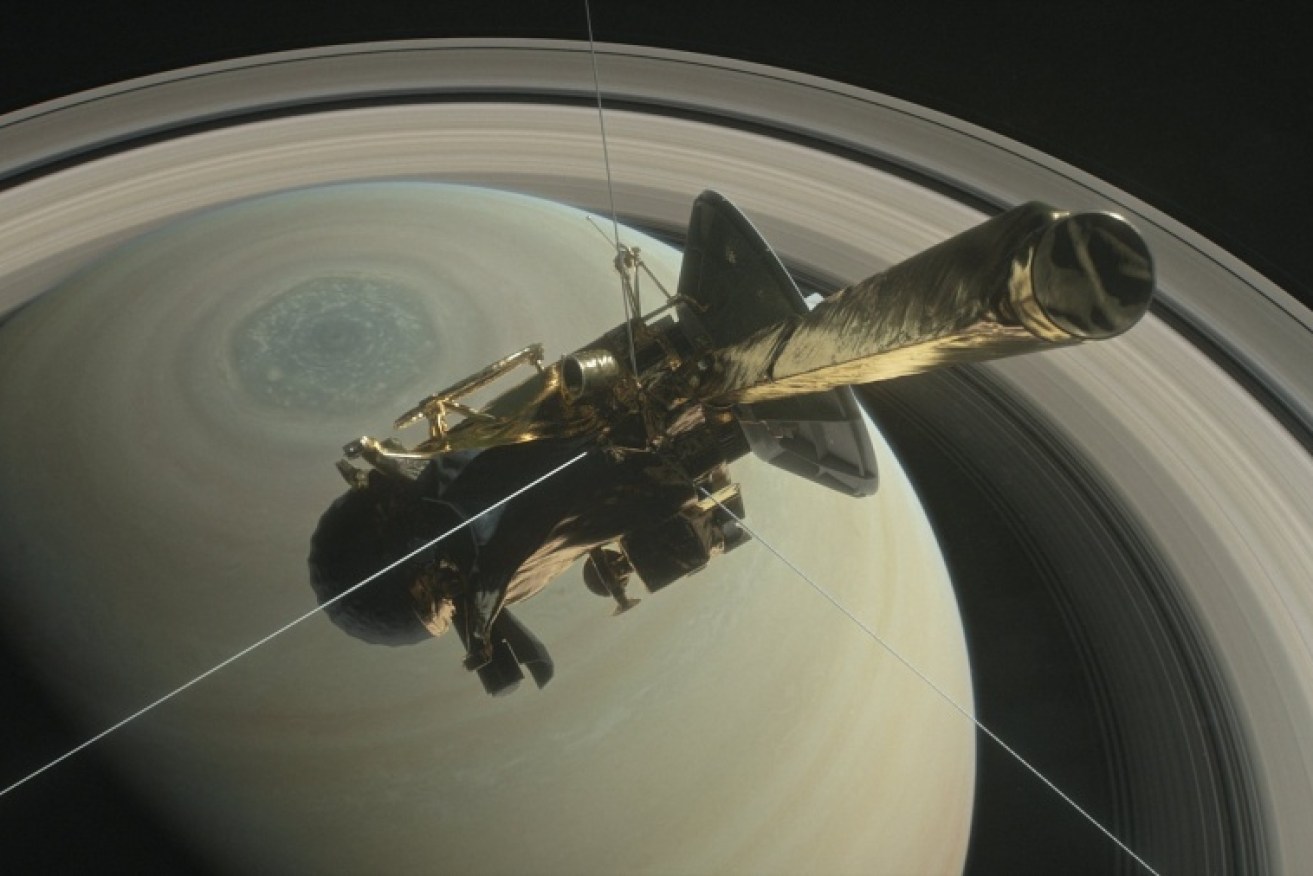Emotional scenes as Saturn’s Cassini probe comes to fiery end after an exhilarating 20-year journey

The Cassini spacecraft was launched in 1997 and its "grand finale" was over in a minute as it crashed into Saturn's atmosphere. Photo: Getty
The 7.9-billion-kilometre journey of the Cassini probe to explore the distant planet Saturn has come to a crashing end, having discovered moons that might hold the key ingredients for life.
It had been a 20-year mission through space that took less than a minute to come to a fiery end, with the probe burning up on entry to Saturn just before 10:00pm (AEST) on Friday.
Dutiful to the end, the Cassini snapped its last photos and sampled Saturn’s atmosphere as it made its final plunge. It was over in a minute or two.
Cassini’s final transmission was met with a round of applause in NASA’s Jet Propulsion Laboratory (JPL).
Program manager Earl Maize made the official pronouncement:
“This has been an incredible mission, an incredible spacecraft and you’re all an incredible team,” Maize said. “I’m going to call this the end of mission.”
Our @CassiniSaturn spacecraft is now one with the planet it studied for so long. The rest is science. #GoodbyeCassini#GrandFinale pic.twitter.com/abVTba8tNm
— NASA JPL (@NASAJPL) September 15, 2017
Flight controllers wearing matching purple shirts stood and embraced and shook hands. Project scientist Linda Spilker also had a purple handkerchief to wipe away tears.
“It felt so much like losing a friend,” she told reporters a couple of hours later.

Cassini program manager at JPL, Earl Maize and spacecraft operations team manager for the Cassini mission at Saturn, Julie Webster, embrace after the Cassini spacecraft plunged into Saturn on Friday. Photo: NASA/Joel Kowsky
“Cassini showed us the beauty of Saturn. It revealed the best in us. Now it’s up to us to keep exploring,” a tweet from the official Cassini account read.
The Cassini mission discovered a global ocean on one of Saturn’s moons — Enceladus — that contained geyser-like jets that spew water vapor and ice particles from beneath the icy crust.
According to NASA, before Cassini launched in 1997 it wasn’t clear that anywhere beyond Mars contained liquid water, essential chemical elements, and energy — such as sunlight — thought to be required for life.
NASA believes that Enceladus “is now one of the most promising places in our solar system to search for present-day life beyond Earth”.
The mission also carried a probe from the European Space Agency that landed on Saturn’s largest moon, Titan.
That too found clear evidence of prebiotic chemicals in the atmosphere and a global ocean beneath the moon’s icy crust.
To truly reveal the wonders of Saturn, we had to go there. Look back at @CassiniSaturn's 13 amazing years exploring the planet pic.twitter.com/oApb3UJSSF
— NASA (@NASA) September 15, 2017
Some researchers believe that ocean contains the hydrothermal chemistry that could provide energy for life.
On Saturn itself, NASA scientists discovered a massive 30,000km hexagonal jet stream on the planet’s north pole.
No-one really knows what drives it — or why it has six sides — but scientists have been studying the vortex at its centre to get a better understanding of how hurricanes on Earth come about.
To avoid contaminating Enceladus or Titan with Cassini’s plutonium-powered remnants, scientists decided to crash it into Saturn instead.
Saturn as a planet is more than 700 times the volume of Earth, and mostly filled with deep, dense and hot gas, and compressed metallic hydrogen, with some helium and other trace molecules thrown in as well.
With its final burst of fuel, the spacecraft spent its final few months diving in and out of Saturn’s rings to give information about the gravity and the mass of the planet.
Like so many missions before it, the Deep Space Communication Complex in Canberra tracked Cassini for every final second of its final mission.

Cassini’s final image before its plunge. Photo: Robyn Beck/AFP/Getty Images
It picked up signals on Friday and locked on for as long as possible.
While Cassini has been travelling, scientists also discovered evidence of a salty global ocean beneath the icy crust of Jupiter’s moon Europa.
The scientific discoveries on Saturn’s Enceladus reinvigorated the desire to explore ocean worlds — with NASA aiming to get a spacecraft to Europa in the next decade.
Many of the lessons learnt from Cassini’s journey to Saturn will greatly help that mission.








